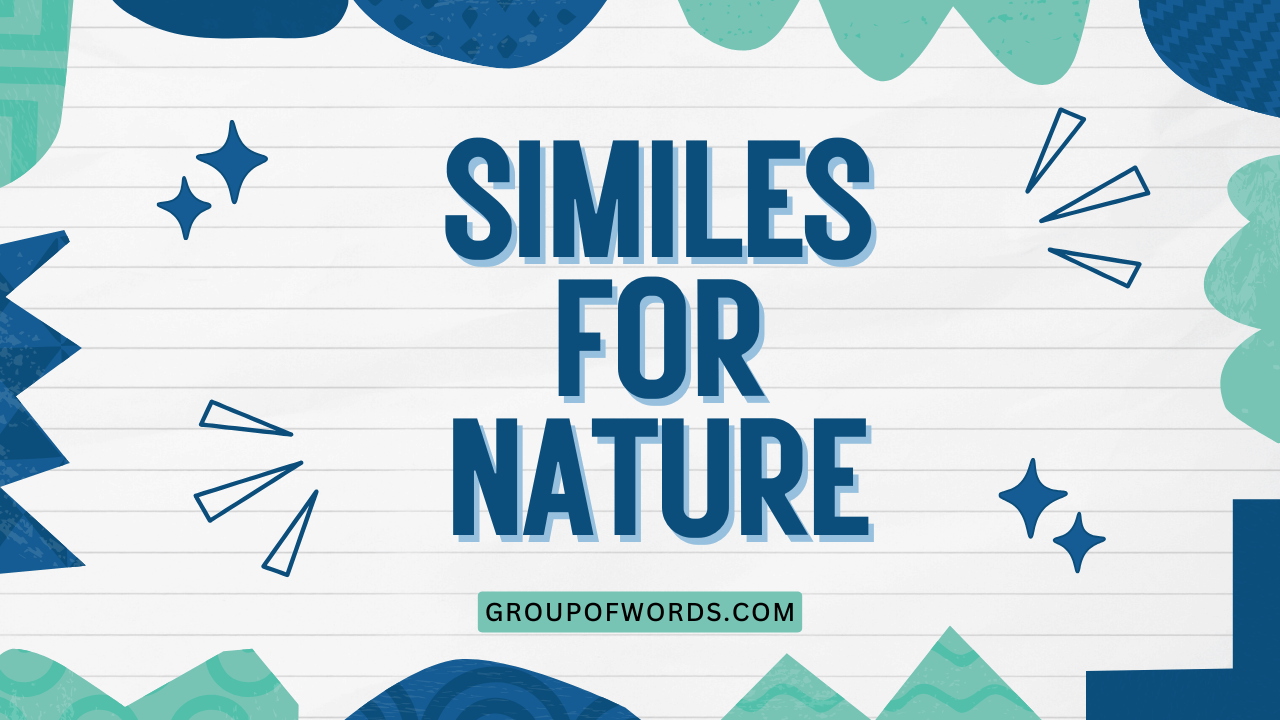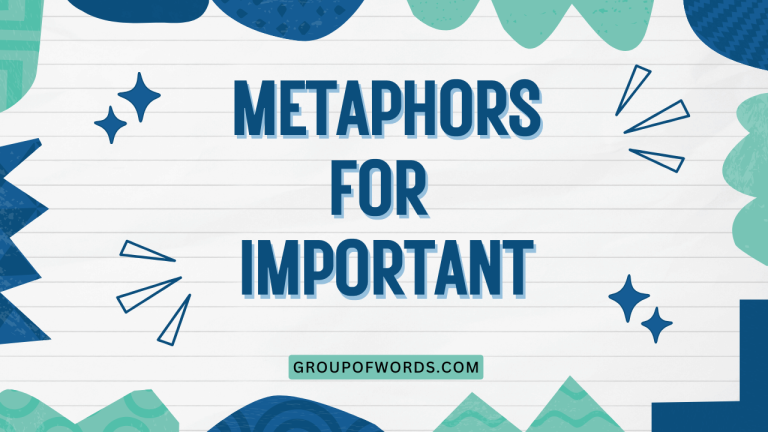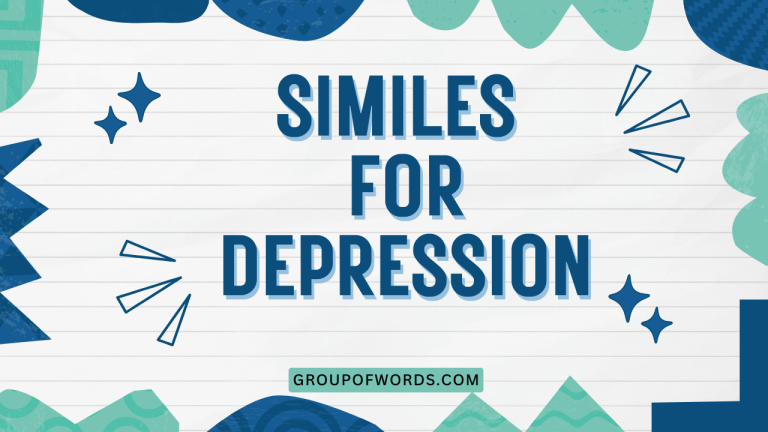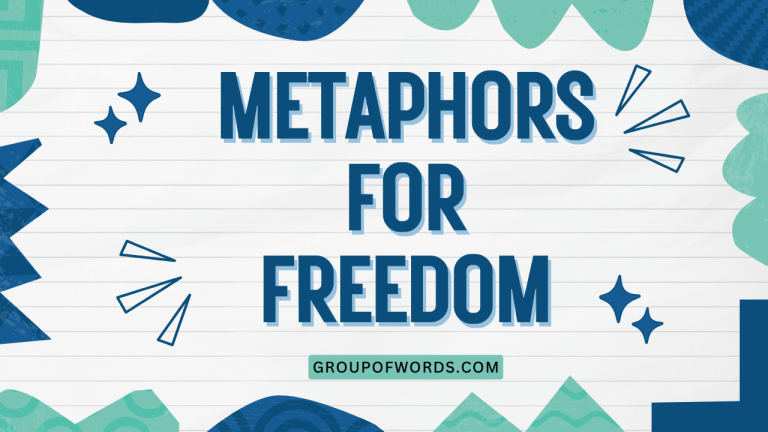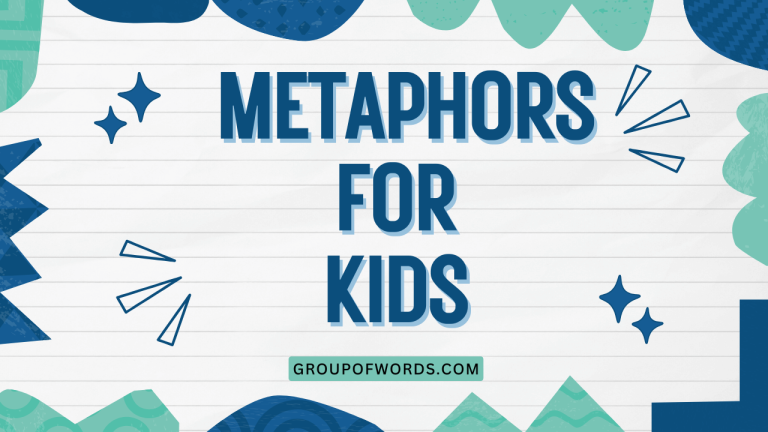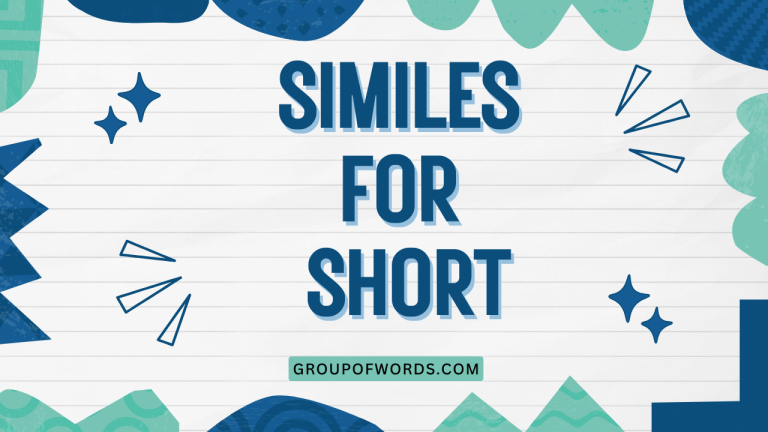Nature’s Poetry: Mastering Similes to Enrich Your Writing
Similes are powerful tools that allow us to paint vivid pictures with words, drawing comparisons between seemingly unlike things to create deeper meaning and understanding. When applied to nature, similes can transform ordinary descriptions into extraordinary experiences, revealing the beauty, power, and complexity of the natural world.
Mastering the art of using similes effectively will not only enhance your writing but also deepen your appreciation for the world around you. This article is designed for students, writers, and anyone eager to improve their English grammar and descriptive abilities.
Through clear explanations, numerous examples, and practical exercises, you’ll learn how to harness the power of similes to bring nature to life in your writing.
This comprehensive guide will walk you through the definition of similes, their structural components, various categories, usage rules, and common mistakes to avoid. You’ll also find plenty of examples and exercises to help you practice and refine your skills.
Whether you’re a beginner or an advanced learner, this article will provide you with the knowledge and tools you need to use similes effectively and creatively.
Table of Contents
- 1. Definition of Simile
- 2. Structural Breakdown of Similes
- 3. Types of Similes
- 4. Examples of Similes for Nature
- 5. Usage Rules for Similes
- 6. Common Mistakes with Similes
- 7. Practice Exercises
- 8. Advanced Topics: Metaphors vs. Similes
- 9. Frequently Asked Questions (FAQ)
- 10. Conclusion
1. Definition of Simile
A simile is a figure of speech that compares two different things using the words “like” or “as.” The purpose of a simile is to create a vivid and imaginative connection between the two things being compared, enhancing the reader’s understanding and appreciation of both. Similes are essential tools for writers because they allow them to express complex ideas in a simple and relatable way, making their writing more engaging and memorable.
In essence, a simile functions as a bridge, linking the familiar to the unfamiliar. By drawing a parallel between two distinct entities, similes illuminate specific qualities or characteristics of the subject being described.
This technique is particularly effective when describing abstract concepts or intricate details of nature, as it helps to make them more accessible and understandable.
2. Structural Breakdown of Similes
The structure of a simile is relatively straightforward. It typically consists of three key components: the subject, the comparative word (like or as), and the object of comparison.
Understanding these components is crucial for constructing effective and meaningful similes.
The subject is the thing being described or compared. In the context of nature writing, this could be anything from a towering mountain to a delicate flower. The comparative word, either “like” or “as,” signals that a comparison is being made. The object of comparison is the thing to which the subject is being compared. This object should share a common characteristic with the subject, allowing for a meaningful and insightful comparison. For example, in the simile “The river flowed like a ribbon,” the river is the subject, “like” is the comparative word, and “a ribbon” is the object of comparison. The shared characteristic is the smooth, flowing movement.
Here’s a breakdown of the structural elements:
- Subject: The thing being described (e.g., the sun)
- Comparative Word: “like” or “as”
- Object of Comparison: The thing it is being compared to (e.g., a golden coin)
The complete simile would then be: “The sun shone like a golden coin.”
3. Types of Similes
While all similes serve the same basic function of comparison, they can be broadly categorized into two main types: direct similes and implied similes. Understanding the difference between these types can help you use similes more effectively in your writing.
3.1 Direct Similes
Direct similes are the most common and straightforward type of simile. They explicitly state the comparison using the words “like” or “as.” This type of simile leaves no room for ambiguity, making the comparison clear and easy to understand.
Direct similes are often used to highlight a specific similarity between two things, creating a vivid image in the reader’s mind.
For example: “The leaves were as green as emeralds.” This simile directly compares the color of the leaves to the color of emeralds, emphasizing their vibrant green hue.
3.2 Implied Similes
Implied similes, also known as indirect similes, are more subtle and require the reader to infer the comparison. While they still use comparison, they do so without explicitly stating “like” or “as.” Instead, they suggest the comparison through descriptive language and imagery.
This type of simile can be more nuanced and sophisticated, adding depth and complexity to your writing.
For example: “The wind whispered secrets through the trees.” This simile implies that the wind is behaving like a person who whispers secrets. The comparison is not directly stated, but it is suggested through the use of the verb “whispered,” which is typically associated with human speech.
4. Examples of Similes for Nature
Similes are particularly effective when used to describe the beauty and complexity of nature. By comparing natural elements to familiar objects or concepts, you can create vivid images and enhance the reader’s understanding of the natural world.
Here are several examples of similes for different aspects of nature, categorized for clarity.
4.1 Similes for the Sky
The sky is a vast and ever-changing canvas, offering endless opportunities for simile creation. From its color to its movement, the sky can be compared to a wide range of things, allowing you to capture its beauty and dynamism in your writing.
The following table contains diverse examples of similes used to describe the sky.
| Simile | Explanation |
|---|---|
| The sky was as blue as a robin’s egg. | Compares the sky’s color to the specific shade of a robin’s egg. |
| Clouds drifted like fluffy cotton balls. | Compares the clouds’ appearance and movement to light, airy cotton balls. |
| The sunset burned like a fiery furnace. | Emphasizes the intense heat and vibrant colors of the sunset. |
| The stars twinkled like diamonds scattered on black velvet. | Highlights the stars’ brilliance and their contrast against the dark night sky. |
| The moon hung like a silver coin in the inky sky. | Describes the moon’s shape and color, contrasting it with the dark sky. |
| The dawn broke like a gentle whisper. | Captures the quiet and gradual arrival of dawn. |
| The storm clouds gathered like an angry mob. | Conveys the threatening and chaotic nature of gathering storm clouds. |
| The sky wept like a grieving widow. | Personifies the sky, describing the rain as tears. |
| The rainbow arched like a colorful bridge. | Highlights the rainbow’s shape and vibrant colors. |
| The lightning flashed like a photographer’s bulb. | Emphasizes the sudden and intense burst of light from the lightning. |
| The sky was as clear as glass. | Describes the sky’s transparency and lack of clouds. |
| The clouds were shaped like castles in the air. | Highlights the imaginative shapes of the clouds. |
| The sun peeked out like a shy child. | Personifies the sun, describing its hesitant appearance. |
| The sky glowed like a pearl. | Compares the sky’s soft, iridescent light to a pearl. |
| The fog rolled in like a ghostly blanket. | Describes the fog’s movement and its opaque, enveloping quality. |
| The twilight faded like a watercolor painting. | Captures the gradual and subtle changes in color during twilight. |
| The sky was as vast as an ocean. | Illustrates the immense size and boundless quality of the sky. |
| The clouds sailed by like ships on a sea. | Depicts the movement of the clouds as similar to ships sailing. |
| The sun beat down like a hammer. | Emphasizes the intense and forceful heat of the sun. |
| The sky at night was like a canvas dotted with paint. | Describes the scattered appearance of stars in the night sky. |
| The sky opened up like a stage curtain. | Illustrates a sudden change in weather, like rain starting abruptly. |
| The sky was as dark as ink. | Describes the deep, intense darkness of the sky. |
| The moon shone like a spotlight. | Emphasizes the bright, focused light of the moon. |
| The clouds parted like curtains. | Depicts the clearing of the sky as clouds separate. |
4.2 Similes for Water
Water, in its various forms, is a constant source of inspiration. Whether it’s a raging ocean or a gentle stream, water can be described using similes that capture its movement, color, and power.
Here’s a table providing similes to describe the water.
| Simile | Explanation |
|---|---|
| The river flowed like liquid glass. | Describes the smooth, reflective surface of the river. |
| The waves crashed like thunder. | Emphasizes the loud, powerful sound of the waves. |
| The lake was as still as a mirror. | Highlights the lake’s calm, reflective surface. |
| The waterfall cascaded like a curtain of diamonds. | Describes the waterfall’s appearance and sparkle. |
| The ocean roared like a hungry beast. | Personifies the ocean, conveying its power and potential danger. |
| The stream trickled like a gentle laugh. | Describes the soft, pleasant sound of the stream. |
| The ice sparkled like a million tiny jewels. | Highlights the ice’s brilliance and intricate structure. |
| The fog hung over the water like a shroud. | Conveys the fog’s dense, obscuring quality. |
| The rain fell like a thousand tiny needles. | Emphasizes the sharp, stinging sensation of the rain. |
| The puddle reflected the sky like a miniature world. | Highlights the puddle’s reflective quality and its ability to mirror the sky. |
| The water was as cold as ice. | Emphasizes the water’s extremely low temperature. |
| The waves danced like playful children. | Personifies the waves, describing their lively, energetic movement. |
| The sea stretched out like a vast, blue carpet. | Highlights the sea’s immense size and uniform color. |
| The river snaked through the valley like a silver ribbon. | Describes the river’s winding path and reflective surface. |
| The tide crept in like a thief in the night. | Personifies the tide, conveying its slow, stealthy movement. |
| The rapids churned like a washing machine. | Emphasizes the turbulent, chaotic movement of the rapids. |
| The water glistened like polished steel. | Describes the water’s smooth, reflective surface. |
| The pool was as clear as crystal. | Highlights the pool’s transparency and purity. |
| The waterfall plunged like a roaring beast. | Emphasizes the power and noise of the waterfall. |
| The lake shimmered like a mirage. | Suggests the lake’s deceptive, ethereal appearance. |
| The water was as smooth as glass. | Describes the still, unruffled surface of the water. |
| The ocean was as deep as despair. | Illustrates the immeasurable depth and mystery of the ocean. |
| The waves crashed like cymbals clashing. | Emphasizes the sharp, resonant sound of the waves. |
| The river whispered like an old friend. | Personifies the river, describing its gentle, comforting sound. |
4.3 Similes for Land
The land, in all its diverse forms, provides a rich source of inspiration for similes. Mountains, deserts, forests, and fields can all be described using similes that capture their unique characteristics and evoke a sense of place.
The following table contains similes describing various aspects of the land.
| Simile | Explanation |
|---|---|
| The mountains stood like silent giants. | Personifies the mountains, emphasizing their size and imposing presence. |
| The desert stretched out like a sea of sand. | Highlights the desert’s vastness and uniform appearance. |
| The forest was as dark as night. | Emphasizes the forest’s density and lack of light. |
| The fields rolled like a green carpet. | Describes the fields’ gentle, undulating shape and uniform color. |
| The cliffs dropped like a sudden plunge into darkness. | Emphasizes the steepness and danger of the cliffs. |
| The valley lay like a peaceful cradle. | Describes the valley’s sheltered, tranquil atmosphere. |
| The rocks were as hard as iron. | Emphasizes the rocks’ durability and resistance. |
| The path wound like a snake through the grass. | Describes the path’s curving, twisting route. |
| The hill rose like a gentle swell. | Highlights the hill’s gradual, rounded shape. |
| The canyon echoed like a hollow drum. | Emphasizes the canyon’s echoing qualities. |
| The ground was as dry as bone. | Emphasizes the extreme dryness of the ground. |
| The plains stretched out like an endless canvas. | Highlights the plains’ vastness and lack of features. |
| The caves were as silent as tombs. | Emphasizes the caves’ quiet, still atmosphere. |
| The soil was as rich as chocolate cake. | Highlights the soil’s fertility and dark color. |
| The sand was as hot as fire. | Emphasizes the extreme heat of the sand. |
| The landscape was as barren as the moon. | Illustrates the lack of vegetation and life in the landscape. |
| The mountains loomed like ancient guardians. | Personifies the mountains, conveying their age and protective presence. |
| The fields were as golden as honey. | Describes the color of the fields, suggesting richness and warmth. |
| The forest floor was like a soft, green sponge. | Highlights the texture and moisture of the forest floor. |
| The rocks were as smooth as polished stones. | Emphasizes the rocks’ texture and worn appearance. |
| The land was as flat as a pancake. | Describes the uniform level of the land. |
| The desert shimmered like a heat mirage. | Suggests the deceptive and distorted appearance of the desert. |
| The valley nestled like a hidden jewel. | Highlights the valley’s beauty and secluded location. |
| The mountain peak was as sharp as a knife. | Emphasizes the mountain’s pointed, jagged shape. |
4.4 Similes for Plants
Plants, in their diverse forms, provide a rich source of inspiration for similes. Trees, flowers, and grasses can all be described using similes that capture their unique characteristics and evoke a sense of life and growth.
Here’s a table providing examples.
| Simile | Explanation |
|---|---|
| The tree stood tall like a sentinel. | Personifies the tree, emphasizing its height and watchful presence. |
| The flower bloomed like a burst of color. | Highlights the flower’s sudden appearance and vibrant hues. |
| The grass swayed like a dancer in the breeze. | Personifies the grass, describing its graceful movement. |
| The leaves rustled like whispers. | Emphasizes the soft, quiet sound of the leaves. |
| The vine climbed like a determined explorer. | Personifies the vine, conveying its persistent growth. |
| The roots clung like tenacious fingers. | Personifies the roots, emphasizing their firm grip. |
| The branches reached like outstretched arms. | Personifies the branches, suggesting a welcoming gesture. |
| The petals were as soft as velvet. | Emphasizes the petals’ delicate texture. |
| The trunk was as rough as sandpaper. | Emphasizes the trunk’s coarse texture. |
| The seeds scattered like tiny parachutes. | Describes the seeds’ descent and dispersal. |
| The plant was as green as jade. | Emphasizes the plant’s vibrant green color. |
| The flowers nodded like sleepy heads. | Personifies the flowers, describing their gentle movement. |
| The tree’s shadow stretched like a long, dark arm. | Describes the tree’s elongated shadow. |
| The leaves shimmered like emeralds in the sunlight. | Highlights the leaves’ brilliance and color. |
| The bark was as thick as armor. | Emphasizes the bark’s protective quality. |
| The forest was as still as a painting. | Illustrates the quiet, unchanging atmosphere of the forest. |
| The trees stood like cathedral pillars. | Compares the trees to the tall, imposing columns of a cathedral. |
| The flowers danced like ballerinas in the wind. | Personifies the flowers, conveying their graceful movement. |
| The grass was as soft as silk. | Highlights the grass’s smooth, delicate texture. |
| The leaves fell like golden rain. | Describes the falling leaves as a beautiful, abundant shower. |
| The tree stood like a lonely giant. | Emphasizes the tree’s solitary presence and large size. |
| The flowers glowed like tiny lanterns. | Suggests the flowers’ bright, radiant appearance. |
| The vines twisted like tangled snakes. | Describes the vines’ complex, intertwined shape. |
| The roots burrowed like hidden secrets. | Personifies the roots, conveying their hidden, mysterious nature. |
4.5 Similes for Animals
Animals, with their diverse behaviors and characteristics, provide a rich source of inspiration for similes. Birds, mammals, insects, and reptiles can all be described using similes that capture their unique qualities and evoke a sense of wonder.
The table provides examples of similes for animals.
| Simile | Explanation |
|---|---|
| The bird flew like an arrow. | Emphasizes the bird’s speed and directness. |
| The deer moved as silently as a shadow. | Highlights the deer’s quiet, stealthy movement. |
| The bee buzzed like a tiny motor. | Emphasizes the bee’s distinct sound. |
| The snake slithered like a ribbon across the sand. | Describes the snake’s smooth, sinuous movement. |
| The lion roared like thunder. | Emphasizes the lion’s powerful, resonant roar. |
| The butterfly fluttered like a painted dream. | Describes the butterfly’s delicate, colorful flight. |
| The fish swam like a torpedo. | Emphasizes the fish’s speed and streamlined shape. |
| The owl hooted like a mournful ghost. | Emphasizes the owl’s eerie, haunting call. |
| The wolf howled like a lonely soul. | Personifies the wolf, conveying its sense of isolation. |
| The squirrel darted like a flash of lightning. | Emphasizes the squirrel’s quick, sudden movements. |
| The cat moved as gracefully as a dancer. | Highlights the cat’s elegant, fluid movements. |
| The dog barked like a security alarm. | Emphasizes the dog’s loud, warning bark. |
| The elephant lumbered like a walking mountain. | Emphasizes the elephant’s size and slow, heavy movements. |
| The spider spun its web like a meticulous artist. | Personifies the spider, conveying its careful, detailed work. |
| The turtle crawled like a slow-motion movie. | Emphasizes the turtle’s extremely slow pace. |
| The flock of birds flew like a swirling cloud. | Illustrates the birds’ coordinated, fluid movement. |
| The ants marched like a tiny army. | Compares the ants to a disciplined, organized group. |
| The frog jumped like a coiled spring. | Emphasizes the frog’s sudden, powerful leap. |
| The rabbit hopped like a furry pogo stick. | Highlights the rabbit’s bouncy, energetic movements. |
| The eagle soared like a king surveying his domain. | Personifies the eagle, conveying its majestic, commanding presence. |
| The lion slept like a contented kitten. | Contrasts the lion’s powerful nature with a peaceful image. |
| The snake coiled like a living rope. | Describes the snake’s shape and flexible movement. |
| The deer ran as fast as the wind. | Emphasizes the deer’s incredible speed. |
| The bear slept like a hibernating log. | Illustrates the bear’s motionless, dormant state. |
5. Usage Rules for Similes
Using similes effectively requires adherence to certain rules. While similes are creative tools, they should be used judiciously to enhance, not detract from, your writing.
The key is to ensure that the comparison is both meaningful and clear.
1. Clarity: The comparison should be easily understood by the reader. Avoid obscure or overly complex comparisons that might confuse rather than clarify.
2. Relevance: The object of comparison should share a relevant characteristic with the subject. The comparison should highlight a specific quality or feature of the subject.
3. Originality: Strive for original similes that offer a fresh perspective. Avoid clichés or overused comparisons that have lost their impact.
4. Context: Ensure that the simile fits the overall tone and style of your writing. A simile that is too whimsical or outlandish might be inappropriate in a serious or formal context.
5. Avoid Mixed Metaphors: Be careful not to combine a simile with a metaphor that creates a confusing or contradictory image.
For example, instead of saying, “The idea was as bright as the sun, but it quickly withered like a flower,” which mixes a simile (“as bright as the sun”) with a metaphor (“withered like a flower”), maintain consistency and say, “The idea was as bright as the sun, but it quickly faded like a sunset.”
6. Common Mistakes with Similes
Even experienced writers can make mistakes when using similes. Being aware of these common errors can help you avoid them and use similes more effectively.
1. Using Clichés: Avoid overused similes such as “as busy as a bee” or “as strong as an ox.” These comparisons have lost their impact and can make your writing seem unoriginal.
2. Illogical Comparisons: Ensure that the comparison makes sense. For example, saying “The tree was as loud as a trumpet” doesn’t work because trees don’t produce sound in the same way a trumpet does.
3. Overusing Similes: Too many similes can clutter your writing and distract the reader. Use them sparingly and only when they add significant value.
4. Mixing Similes and Metaphors Inappropriately: While it’s possible to use both similes and metaphors in the same piece of writing, avoid mixing them within the same sentence or phrase in a way that creates confusion.
Here are some examples of correct and incorrect simile usage:
| Incorrect | Correct | Explanation |
|---|---|---|
| The sky was as blue as blue. | The sky was as blue as a sapphire. | The comparison should be more specific and evocative. |
| The river flowed like water. | The river flowed like liquid glass. | The comparison should offer a new perspective or insight. |
| He was as tall as a house. | He was as tall as a skyscraper. | Using a more appropriate comparison for extreme height. |
7. Practice Exercises
The best way to master similes is through practice. The following exercises will help you develop your simile-writing skills and reinforce your understanding of the concepts discussed in this article.
7.1 Exercise 1: Identifying Similes
Identify the similes in the following sentences. Underline the simile and identify the two things being compared.
| Question | Answer |
|---|---|
| 1. The sun shone like a spotlight on the stage. | The sun shone like a spotlight. Sun and Spotlight. |
| 2. The wind howled like a wolf in the night. | The wind howled like a wolf. Wind and Wolf. |
| 3. The snow fell as softly as feathers. | The snow fell as softly as feathers. Snow and Feathers. |
| 4. The lake was as still as a mirror. | The lake was as still as a mirror. Lake and Mirror. |
| 5. The leaves danced like ballerinas in the wind. | The leaves danced like ballerinas. Leaves and Ballerinas. |
| 6. The river snaked through the valley like a silver ribbon. | The river snaked through the valley like a silver ribbon. River and Ribbon. |
| 7. The mountains stood like silent giants. | The mountains stood like silent giants. Mountains and Giants. |
| 8. The clouds drifted like fluffy cotton balls. | The clouds drifted like fluffy cotton balls. Clouds and Cotton Balls. |
| 9. The stars twinkled like diamonds in the sky. | The stars twinkled like diamonds. Stars and Diamonds. |
| 10. The fog rolled in like a ghostly blanket. | The fog rolled in like a ghostly blanket. Fog and Blanket. |
7.2 Exercise 2: Completing Similes
Complete the following similes with an appropriate comparison.
| Question | Answer |
|---|---|
| 1. The sky was as dark as _____. | The sky was as dark as ink. |
| 2. The rain fell like _____. | The rain fell like tears. |
| 3. The trees stood tall like _____. | The trees stood tall like sentinels. |
| 4. The flowers bloomed like _____. | The flowers bloomed like stars. |
| 5. The river flowed as smooth as _____. | The river flowed as smooth as glass. |
| 6. The moon shone like _____. | The moon shone like a pearl. |
| 7. The wind whispered like _____. | The wind whispered like a secret. |
| 8. The leaves rustled like _____. | The leaves rustled like paper. |
| 9. The waves crashed like _____. | The waves crashed like thunder. |
| 10. The sun was as hot as _____. | The sun was as hot as fire. |
7.3 Exercise 3: Writing Your Own Similes
Write your own similes to describe the following elements of nature.
| Element of Nature | Your Simile |
|---|---|
| 1. A mountain | The mountain stood like a weathered statue. |
| 2. A forest | The forest was as silent as a sleeping giant. |
| 3. A stream | The stream babbled like a happy child. |
| 4. A sunset | The sunset burned like a painter’s masterpiece. |
| 5. A field of wildflowers | The field of wildflowers was as colorful as a patchwork quilt. |
| 6. A snowstorm | The snowstorm raged like an angry beast. |
| 7. A rainbow | The rainbow arched like a bridge to a magical land. |
| 8. The desert | The desert shimmered like a mirage in the sun. |
| 9. The ocean | The ocean stretched out like an endless blue canvas. |
| 10. A meadow | The meadow swayed like a sea of green. |
8. Advanced Topics: Metaphors vs. Similes
While similes and metaphors both serve the purpose of comparison, they do so in different ways. Understanding the nuances between these two figures of speech can elevate your writing and allow you to use each more effectively.
A simile explicitly states a comparison using “like” or “as.” It acknowledges that the two things being compared are different but share a common characteristic. A metaphor, on the other hand, implies a comparison by stating that one thing is another. It asserts a stronger, more direct relationship between the two things being compared.
For example:
- Simile: “The sky was like a blue canvas.” (explicit comparison)
- Metaphor: “The sky was a blue canvas.” (implied comparison, asserting identity)
Metaphors can add depth and intensity to your writing, but they also require a more careful and deliberate approach. A poorly chosen metaphor can be confusing or nonsensical, while a well-crafted metaphor can create a powerful and lasting impression.
Here’s a table summarizing the key differences:
| Feature | Simile | Metaphor |
|---|---|---|
| Comparison | Explicit (using “like” or “as”) | Implicit (stating one thing is another) |
| Relationship | Acknowledges difference | Asserts identity |
| Intensity | Less intense | More intense |
| Clarity | Generally clearer | Can be more nuanced or ambiguous |
9. Frequently Asked Questions (FAQ)
What is the difference between a simile and a metaphor?
A simile uses “like” or “as” to make a comparison, while a metaphor directly equates two things without using those words. For example, “He is as brave as a lion” (simile) versus “He is a lion” (metaphor).
Can a simile be a cliché?
Yes, if it’s overused and lacks originality. Try to create fresh and imaginative comparisons to avoid clichés.
How can I improve my simile-writing skills?
Practice regularly, read widely, and pay attention to the comparisons used by other writers. Also, focus on making your similes clear, relevant, and original.
Is it okay to use similes and metaphors together in my writing?
Yes, but use them judiciously. Mixing them inappropriately within the same sentence or phrase can create confusion.
Make sure each comparison enhances your writing.
How important is it to use similes in descriptive writing?
Similes are valuable tools for descriptive writing as they help create vivid images and enhance the reader’s understanding. However, they are not essential, and good writing can also be achieved through other descriptive techniques.
What if I can’t think of a good simile?
Don’t force it. Sometimes, a straightforward description is better than a weak or illogical simile.
Keep practicing, and the ideas will come more easily over time.
Are similes only useful for describing nature?
No, similes can be used to describe anything—people, emotions, objects, ideas, etc. They are versatile tools for enhancing any type of writing.
Can a simile be too complex?
Yes, if the comparison is too obscure or requires too much background knowledge, it can confuse the reader. Aim for clarity and relevance in your comparisons.
How do I know if a simile is effective?
An effective simile should create a vivid image, enhance understanding, and add depth to your writing. Ask yourself if the comparison is clear, relevant, and original.
10. Conclusion
Mastering the art of using similes can significantly enhance your writing, allowing you to paint vivid pictures with words and create deeper connections with your readers. By understanding the structure, types, and usage rules of similes, and by avoiding common mistakes, you can use these powerful tools to bring your descriptions of nature—and everything else—to life.
Remember, practice is key. The more you experiment with similes, the more natural and effective your writing will become.
So go forth, explore the world around you, and let your creativity soar as you craft similes that capture the beauty and wonder of nature.
